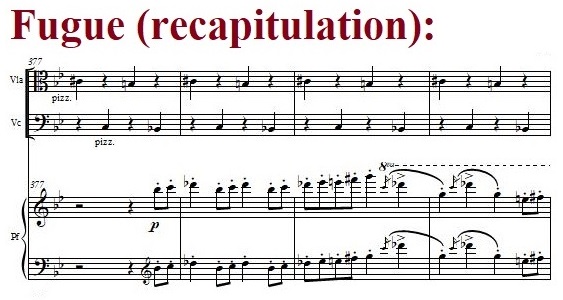The Octatonic Collection in the Piano Quartet
As with many of my compositions, much of my Piano Quartet is lushly Romantic. The second theme of this sonata-form work, however, has a sharply contrasting character, probably best described as diabolical. It consists of a fugue presented over an ostinato figure in the deep bass register of the piano:

The piano’s ostinato figure follows a descending chromatic pattern, which (as discussed in my last post) characterizes all the major themes in this work and links them into a unified whole.

The energetic fugue subject, mostly staccato and enlivened by syncopated accents, is based on the octatonic collection. (The octatonic collection, also called the “octatonic set,” was discussed in this 2016 blog post and is built in alternating whole steps and half steps.) The subject is heard first in the cello, starting on G2 near the end of bar 53, around 3:30 in the score video at the end of this post. (Some neighbor and passing tones in bars 59-60 fall outside this octatonic collection.) The viola answers in bar 60, beginning on G3. The violin then enters at the tritone, C#5, in b. 68. The right-hand of the piano enters with the subject in b. 74, starting on D5, which of course places that that entry in a different octatonic collection, one semitone above the original. Therefore this fugue is in four voices, consisting of the three string instruments from bottom to top followed by the piano.
Within the development section, the fugue returns in an inverted form near the end of b. 217 (around 12:15 in the video):

The ostinato figure in the piano is now more elaborate, with emphasis placed on the tritone, accentuating the diabolical effect. (In early music, the tritone was referred to as the diabolicus in musica, and it retained its association with the devil for centuries afterward.) The fugue subject is inverted and also abbreviated. Since the inversion of an octatonic collection is itself an octatonic collection, the fugue subject is still perceived as octatonic. The order of the string instruments is also inverted: The subject is presented first by the violin starting in b. 217, answered by the viola in b. 221 and the cello in b. 225. In b. 237 there begins a stretto in which overlapping entries of the subject are presented in rapid succession, beginning with the high register of the piano, followed by the viola, then the violin, and finally the cello.
When the second theme returns in the recapitulation (b. 377, 18:55 in the video), a change in instrumentation gives it a radically different sound:

The ostinato chromatic pattern is now realized by alternating pizzicatos in the viola and cello, in different octaves: C#4-C3-B3-Bb2. This time, the diabolical fugue subject is first presented in octaves in the high register of the piano, where the instrument has a relatively percussive sound. It begins on Bb, and the local tonality can be heard as an octatonic variant of B-flat minor, which is the parallel minor to the quartet’s overall key of B-flat major. The violin answers in b. 384, starting on Bb3, followed by the cello in b. 392, starting at the tritone on E2.
It will be noted that in the fugal patterns in these octatonic sections, the tritone plays a role akin to that of the perfect fifth in traditional fugues. That is a natural consequence of the internal structure of the octatonic set: The set does not contain the perfect fifth interval at all. But transposing the whole set by a tritone (either up or down) generates exactly the same pitch classes as the original set, and consequently the two are considered to be the same set under the rules of musical set theory.
The video below presents the score along with a 2020 recording by violinist Cari Sue Jackson, violist Camille Phillips, cellist Sarah Langford, and myself on the piano.



What a joy when a composer takes the trouble to explain his compositions. Thank you very much
Thanks for reading! Merci, mon amie!